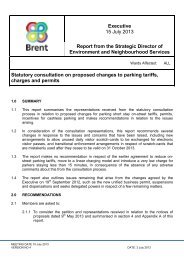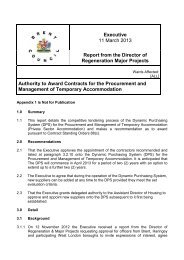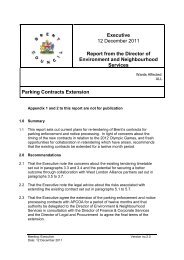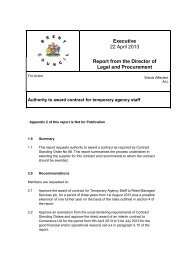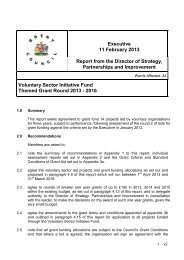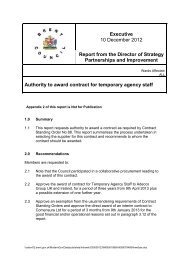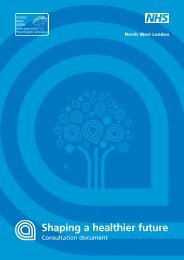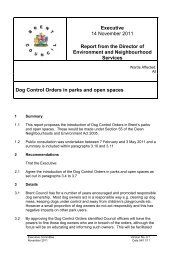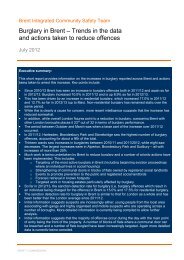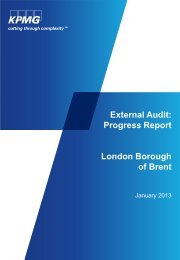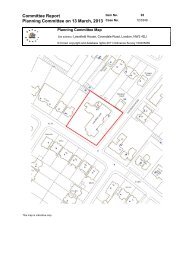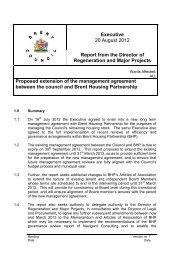wembley-plan-app (small) , item 9. PDF 8 MB - Meetings, agendas ...
wembley-plan-app (small) , item 9. PDF 8 MB - Meetings, agendas ...
wembley-plan-app (small) , item 9. PDF 8 MB - Meetings, agendas ...
- No tags were found...
You also want an ePaper? Increase the reach of your titles
YUMPU automatically turns print PDFs into web optimized ePapers that Google loves.
58Wembley Area Action Plan - Proposed Submission Version6 TransportStrategic Policy6.1 The London Plan and the Mayor’s TransportStrategy seek improvements to public transport,walking and cycling capacity and accessibilitywhere it is needed, including areas designated fordevelopment and regeneration. Although national<strong>plan</strong>ning policy, as expressed in the NPPF, nolonger requires that maximum parking standardsbe <strong>app</strong>lied, the London Plan specifies maximumparking standards for new development with theaim of encouraging a move to sustainable transportmodes and reducing the need to travel by privatecar. Currently, Brent’s parking standards, asprovided in the adopted UDP, do not mirror thosein the London Plan. For Wembley, parkingstandards have been modified to align with thosein the London Plan 2011, bearing in mind theregeneration objectives of the Wembley GrowthArea as well as the potential negative impact thatthis could have on Wembley’s town centres.6.2 London Plan policy for the WembleyOpportunity Area sees upgrades to the 3 stationsas important and recognises that "improvement ofpublic transport will play a key role in managingheavy demand for mass movement" and that "linksbetween the stations and strategic leisure facilitiesshould be improved".6.3 One of the main objectives in Brent's CoreStrategy is that access by public transport, bicycleand on foot should be promoted and car parkingstandards reduced in Growth Areas because oftheir relative accessibility. A specific aim forWembley is to reduce modal share of car trips from37% towards 24 25%.6.4 Policy CP7 of the Core Strategy highlights aneed for new road connections and junctionimprovements in the Wembley regeneration area,these include:North End Road/Bridge Road junction;The Triangle junction of the High Road,Harrow Road and Wembley Hill Road;Widening of the bridge on Wembley Hill Roadover the Chiltern Railway; andConversion from one way to two way operationof South Way and Fifth Way to the east of theStadium.6.5 Policy CP14 highlights a need to enhancethe key interchanges at Wembley Central andWembley Stadium. It also states that the councilwill promote improvements to orbital transportroutes which link strategic centres in North WestLondon and the Growth Areas, making use ofcontributions from development where <strong>app</strong>ropriate.Improved links from Wembley towards Brent Crossand Ealing (via Park Royal) are sought.Improvements to the distribution of buses throughthe Wembley area are a priority.Policy Context6.6 Wembley is a generally well connected area,particularly by public transport and radial links toCentral London. Wembley is served by withconnections from the Metropolitan and Jubilee linesat Wembley Park, the Chiltern line at WembleyStadium station, and from London Overground andthe Bakerloo line at Wembley Central, all of whichprovide key access gateways into Wembley forpublic transport users. Orbital links are primarilyprovided by bus, of which a large number of routespass through Wembley. However, walking andcycling links within and from Wembley to the restof Brent are either poor or non-existent. Largelydue to the rail and underground links, Wembley istherefore can be thought of as a very sustainablelocation for major trip generating development (80%of events crowds choose to use public transport),but to support this, better pedestrian and cycleaccess will be sought in line with Brent’s widertransport strategy . When the level of bus servicesis added, the area has a Public TransportAccessibility Level (PTAL) rating of up to 6 (out of6) which means it is one of the most accessiblelocations in London. However, the PTAL for theWembley Area (shown on Map 6.1) decreasestowards the east with a PTAL of 1 or 2 in theEastern Lands and Industrial Estate. Nevertheless,orbital public transport connections, for examplelinking to Brent Cross or Ealing, are not as goodas the radial connections into central London orouter London and beyond. This is identified as akey area to be addressed by the Core Strategyalthough it should be recognised that the council



